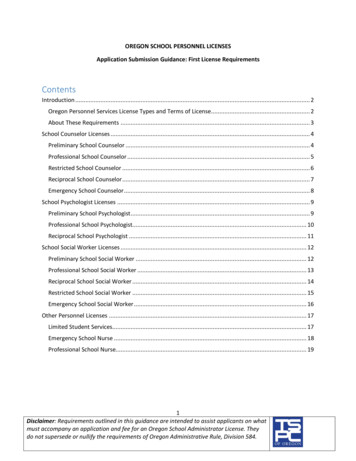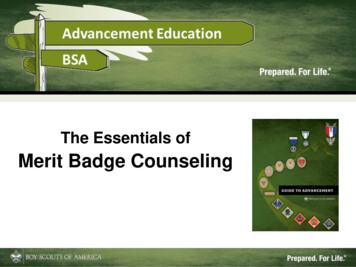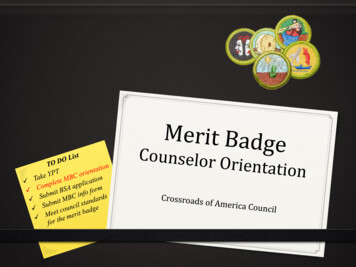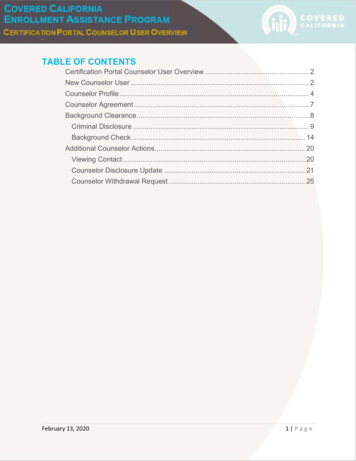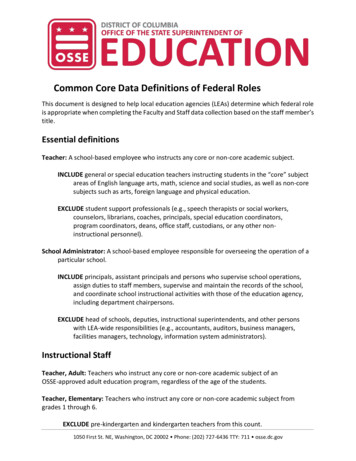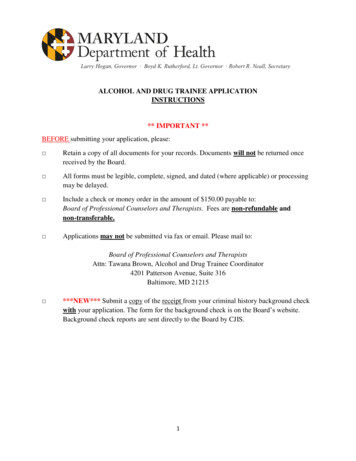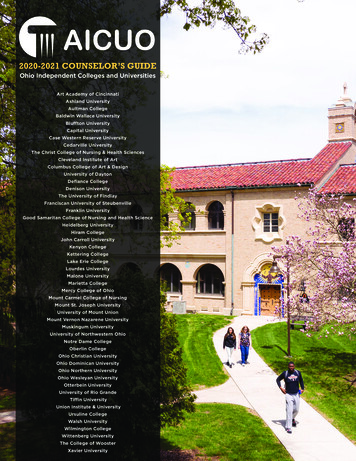
Transcription
2020-2021 COUNSELOR’S GUIDEOhio Independent Colleges and UniversitiesArt Academy of CincinnatiAshland UniversityAultman CollegeBaldwin Wallace UniversityBluffton UniversityCapital UniversityCase Western Reserve UniversityCedarville UniversityThe Christ College of Nursing & Health SciencesCleveland Institute of ArtColumbus College of Art & DesignUniversity of DaytonDefiance CollegeDenison UniversityThe University of FindlayFranciscan University of SteubenvilleFranklin UniversityGood Samaritan College of Nursing and Health ScienceHeidelberg UniversityHiram CollegeJohn Carroll UniversityKenyon CollegeKettering CollegeLake Erie CollegeLourdes UniversityMalone UniversityMarietta CollegeMercy College of OhioMount Carmel College of NursingMount St. Joseph UniversityUniversity of Mount UnionMount Vernon Nazarene UniversityMuskingum UniversityUniversity of Northwestern OhioNotre Dame CollegeOberlin CollegeOhio Christian UniversityOhio Dominican UniversityOhio Northern UniversityOhio Wesleyan UniversityOtterbein UniversityUniversity of Rio GrandeTiffin UniversityUnion Institute & UniversityUrsuline CollegeWalsh UniversityWilmington CollegeWittenberg UniversityThe College of WoosterXavier University
Cover photo provided by: Lourdes University
Table of ContentsThe University of FindlayFranciscan Universityof SteubenvilleFranklin UniversityOhio Independent College Good Samaritan College ofNursing & Health Scienceand University Profiles:Art Academy of Cincinnati11 Heidelberg UniversityAshland University12 Hiram CollegeAultman College13 John Carroll UniversityBaldwin Wallace University14 Kenyon CollegeBluffton University15 Kettering CollegeCapital University16 Lake Erie CollegeCase Western Reserve University17 Lourdes UniversityCedarville University18 Malone UniversityMarietta CollegeThe Christ College of Nursing19 Mercy College of Ohio& Health SciencesCleveland Institute of Art20 Mount Carmel College of NursingColumbus College of Art & Design21 Mount St. Joseph UniversityUniversity of Dayton22 University of Mount UnionDefiance College23 Mount Vernon Nazarene UniversityDenison University24 Muskingum UniversityUniversity of Northwestern OhioWhy Independent Colleges?Frequently Asked QuestionsFinancial 344Notre Dame CollegeOberlin CollegeOhio Christian UniversityOhio Dominican UniversityOhio Northern UniversityOhio Wesleyan UniversityOtterbein UniversityUniversity of Rio GrandeTiffin UniversityUnion Institute & UniversityUrsuline CollegeWalsh UniversityWilmington CollegeWittenberg UniversityThe College of WoosterXavier UniversityDegree ProgramsAthletics & 93Please go to each institution’s website for details onhow and when students are able to visit campus.The Ohio Private College Admission Directors (OPCAD) believes in thedignity, worth, and potential of all human beings and works to eliminateany type of bias from the college admission and financial aid processes.We believe in the importance of ethical practices in the admission andfinancial aid processes by all postsecondary institutions. We endorse thebasic philosophy of the National Association of College Admission Counseling(NACAC), its Code of Ethics, and its Statement of Principles of Good Practice.The Counselor’s Guide to Ohio’sIndependent Colleges and Universities(September 2020, Vol. #32) ispublished annually by the Association ofIndependent Colleges and Universitiesof Ohio and the Ohio Private CollegeAdmission Directors.41 South High Street, Suite 1690Columbus, Ohio 43215www.aicuo.eduwww.ohioprivatecolleges.orgBe it resolved, therefore, that all Ohio colleges and universities not requirecandidates for admission and financial aid to indicate the order of their collegeor university preferences, except under early decision plans.Be it resolved, therefore, that candidates for admission and financial aid bepermitted to choose, without financial penalty, among offers of admission andfinancial aid until they have heard from all colleges and universities to whichthey have applied, or until May 1, whichever is earlier.Be it resolved, therefore, that all Ohio colleges and universities state clearlyin their letter of acceptance to full-time candidates for admission that theysubscribe to the NACAC Statement of Students’ Rights and Responsibilities,and to the NACAC Statement of Principles of Good Practice.Approved by the Ohio Private College Admission Directors (OPCAD).1
Why Independent Colleges?Independent GraduatesHave Higher Starting Salaries 53,025 48,621Independent college graduates earned8.5% more than public counterpartsSource: National Association of Colleges and Employers (2018)4 Year Private,Non-Profit4 Year PublicIndependents Lead in Internship PlacementIndependent college seniors are more likely to haveinternship or field experience58%Private 4 YearSource: National Study for Student EngagementPublic 4 Year50%Who’s Not Defaulting onTheir Student Loans in Ohio?Independent graduates have thelowest student-loan default rate18%14%11%8%Ohio student loan default rates for FY167%Source: U.S. Department of Education (2019)24-Year4-YearIndependent Public2-YearCertificateOhioAverage
The True Cost of College in Ohio 202,288Many Ohio public college graduates take longerto complete, costing moreSource: IPEDS (2016-2017); U.S. Census Bureau (2017) 134,518 16,687 51,083 51,083 16,687 16,687 94,8764-YearIndependentAverageNet Costfor 4 Years 51,083 66,748 66,7484-YearPublic(5th Year)4-YearPublic(6th Year)AverageNet Costfor Year 5AverageNet Costfor Year 6MedianLost IncomeMinority Undergraduates FindOhio Independent Colleges AttractiveIn 10 years, minority enrollment has increased by half.20,096Fall undergraduate minority enrollment at AICUO institutions13,325Fall 2018Fall 2008Source: IPEDS (2008 - 2018)Independent Colleges: Still The Efficient Path4-year on-time graduation rate at Ohio independentsis higher than the 5-year rate at Ohio publicsSource: National Center for Education Statistics;Ohio Department of Higher Education66%64%Baccalaureate Graduation RatesOhio Public Main Campuses and 4-Year IndependentsCohort Entering Fall rIndependent College Tuition and Fees 2020-2021Highest Tuition:Average Tuition:Lowest Tuition:Average aid package: 61,100 32,712 9,577 25,686No. of schools below the average:No. of schools below 15,000:No. of schools w/o app fees:Pct. of freshmen receiving aid:AICUO Tuition and Fees Survey, 2020; National Center for Education Statistics2043497%3
Art Academy of CincinnatiAshland UniversityAultman College of Nursing and Health SciencesBaldwin Wallace UniversityBluffton UniversityCapital UniversityCase Western Reserve UniversityCedarville UniversityThe Christ College of Nursing and Health SciencesCleveland Institute of ArtColumbus College of Art & DesignUniversity of DaytonDefiance CollegeDenison UniversityThe University of FindlayFranciscan University of SteubenvilleFranklin UniversityGood Samaritan College of Nursing and Health ScienceHeidelberg UniversityHiram CollegeJohn Carroll UniversityKenyon CollegeKettering CollegeLake Erie CollegeLourdes NNNYNNNNNNNYNNYYNYNNNYYNYNYNNNYNNYYDo you super score the ACT?NNNYNYYYNYYYYYYNNYYYYYNYYDo you super score the NNYYNYNYNYNYNNNNYYYYNNYYNYNYYFAQDo you require ACT writing?Does your institution useACT writing in the admissionsdecision process?Does your institution use ACTsubscores for placement?Does your institution superscore for scholarships?Do you accept either ACT orSAT?Are you test optional?Do you require ACT/SATdirectly from the testingagency?Do you accept the CommonApplication?Do you accept electronictranscripts?Do you require letter(s) ofrecommendation?Can high school studentsenroll in CCP at yourinstitution?Does your institution offerathletic scholarships?Do you offer full tuitionscholarships?Are scholarships availablebeyond your applicationdeadline?Does your institution allowprospective students to stayovernight in your residencehalls?4
Malone UniversityMarietta CollegeMercy College of OhioMount Carmel College of NursingMount St. Joseph UniversityUniversity of Mount UnionMount Vernon Nazarene UniversityMuskingum UniversityUniversity of Northwestern OhioNotre Dame CollegeOberlin CollegeOhio Christian UniversityOhio Dominican UniversityOhio Northern UniversityOhio Wesleyan UniversityOtterbein UniversityUniversity of Rio GrandeTiffin UniversityUnion Institute & UniversityUrsuline CollegeWalsh UniversityWilmington CollegeWittenberg UniversityThe College of WoosterXavier UniversityFAQNNNNNNNNNNNNNNNNNNNNNNNNNDo you require ACT writing?NNNNNNNNNNNNNNNNNNNNNNNNNACT writing in the admissionsDoes your institution usedecision process?Does your institution use YYYDo you super score the ACT?YYYNYNNYNNYYYYYNNNNYYNYYYDo you super score the NNNNsubscores for placement?Does your institution superscore for scholarships?Do you accept either ACT orSAT?Are you test optional?Do you require ACT/SATdirectly from the YYYYYYYYYYYYYYNYNNNNNNNNYYNNYNNNYNNNNYYDo you accept the CommonApplication?Do you accept electronictranscripts?Do you require letter(s) ofrecommendation?Can high school studentsYYNNNYYYYYNYNYNYYYYNYNYNNenroll in CCP at YNNNYNYYNYNNNNYYDoes your institution offerathletic scholarships?Do you offer full tuitionscholarships?Are scholarships YYYYYYYYNbeyond your applicationdeadline?Does your institution allowprospective students to stayovernight in your residencehalls?5
Financial AidWhy is there a difference in pricebetween public and independentinstitutions?The cost of providing higher education is generally thesame at independent colleges and universities as at publicuniversities. For example, both types of institutions incurcosts associated with building and maintaining classrooms,residence halls, computer facilities and libraries; payingfaculty salaries; and providing career and counselingservices. However, private institutions charge a higher price,or tuition, because they do not receive an instructionalsubsidy from the state.Apply to colleges that best fit personalneeds, regardless of price.The ability to pay for a college education is likely to be animportant factor in selecting a college or university. However,the price of a particular institution should not prevent astudent from applying to the schools of his or her choice.Every student should apply to the colleges that best suit hisor her academic, social and personal needs, regardless ofthe price, because financial aid can make it affordable toattend.A variety of financial aid is available.College financial aid programs help families meet the costsof education beyond their demonstrated ability to pay.Institutional need-based and non-need-based financialaid (scholarships, merit, athletic, leadership awards, etc.)combined with state and federal scholarships, grants,loans and work-study programs make up a financial aidpackage and help defray the cost of attending college. Thecollege will make every effort to compile a suitable financialaid package for the student and family so that the price of acollege education does not become an overriding factor inchoosing an institution.6Complete the FAFSA.Ohio’s independent colleges and universities stronglyrecommend prospective students complete the FreeApplication for Federal Student Aid (FAFSA). To qualify forsome state and federal grant and loan programs, studentsshould complete the FAFSA as soon after October 1 aspossible.Families can complete it online at: http://www.fafsa.gov orobtain copies of the form by contacting a college financialaid office. Some colleges and universities also require asupplemental or institutional financial aid form. Studentsshould contact the college financial aid offices to learnwhich financial aid forms are required and the deadlines forsubmission. See the video tutorial at https://www.finaid.ucsb.edu/fafsasimplification/.
Financial AidFinancial Aid at Ohio’s Independent CollegesWorried about financial aid?Independent institutions give out 400 million inschool-based grants to freshmen. Just ask theirfinancial aid counselors for more information!In AY 2018-2019, 97% of full-time, first-timefreshmen entering AICUO member campusesreceived financial aid, averaging 25,686.Supporting Our Own StudentsAid EligibilityAt Ohio independents, institutions provide 9 out ofevery 10 financial aid dollars to freshmen.Generally, a student’s demonstrated need is equal to thedifference between the Expected Family Contribution(EFC) and the total cost of education (which includestuition and fees, room and board or off-campus livingexpenses, and books). All schools work to award aidto meet the gap between the cost of attendance andEFC, but not all have the same types or amounts of aidavailable. EFC does not change from school to school, butdemonstrated need will.First-time, full-time student aid grants bysource at AICUO members, 2017–18Federal grants 34 million8%State/local grants2% 11 millionSample Demonstrated NeedSchool ACost of Education90%- Family’s EFC Demonstrated NeedSchool B School C 13,715 34,387 40,146 1,500 1,500 1,500 12,215 32,887 38,646Institutional grants 400 millionSource: National Center for Education StatisticsFinancial Aid Step By StepStep 1: Complete the Free Application for Federal Student Aid (FAFSA) at fafsa.gov. Be sure to check that you areinterested in Federal Work Study to gain eligibility for aid programs that require you at least to consider this form of aid. Seethe video tutorial at ep 2: Complete the College Scholarship Services (CSS) Financial Aid PROFILE at https://cssprofile.collegeboard.org, ifrequired by the schools to which you are applying.Step 3: Receive and review your Student Aid Report (SAR) from the U.S. Department of Education, outlining yourExpected Family Contribution (EFC), which is the figure that determines financial aid eligibility.Step 4: Receive and review financial aid award letters from the schools you listed on your FAFSA. All schools striveto award aid to meet the gap between the cost of attendance and your EFC, but not all have the same types or amounts ofaid available.Step 5: Accept the financial aid award offered by the school you plan to attend and notify other schools that you decide notto attend so that they can use their aid dollars for other interested students.Step 6: Let your school know if you receive outside scholarships and grants. You can search for local scholarships throughemployers, government and community organizations, or by using online scholarship databases.Step 7: Complete any forms required to secure the aid awarded by your school.7
Ohio Financial AidIn the last few years, there have been significant changes in the state of Ohio’s student financial aid programs, and there maybe more coming in the near future. Here is a list of the state-funded student aid programs for the 2020-21 academic year. Formore information about state of Ohio student aid, please contact the Office of Financial Aid at the Ohio Department of HigherEducation, toll-free at 1-800-233-6734 or on the web at www.ohiohighered.org/sgs.Ohio College Opportunity Grant (OCOG)OCOG is a need-based aid program for Ohio residentundergraduates. Eligibility for the award is based on eachapplicant’s Estimated Family Contribution (EFC), a figuredetermined by data each student submits in the FreeApplication for Federal Student Aid (FAFSA). To be eligiblefor an OCOG award, an Ohio resident student must have anEFC of 2,190 or less and a family income of 96,000 or less,and attend an Ohio independent or public college. The annualOCOG award for each qualifying student in 2020-21 is 3,500for full-time study at nearly all independent colleges; 2,625for three-quarter-time study; 1,750 for half-time study; and 875 for one-quarter-time study. More information, includingup-to-date award levels, is available at any independentcollege financial aid office.OTTA College Savings ProgramThe Ohio Tuition Trust Authority (OTTA) is a state agencycreated by the Ohio General Assembly in 1989 to promotesavings for higher education. Through its CollegeAdvantage529 Savings Plan, OTTA offers several college savingsoptions. The market-based funds are managed by leadinginvestment firms. Families can choose to participate in allfunds. Investments may be applied at any accredited collegeor university in Ohio or the country. Call 1-800-AFFORDIT for more information, or visit OTTA’s Web site at: www.collegeadvantage.com.Additionally, Ohio residents may deduct up to 4,000 fromtheir Ohio taxable income per year per child made to any ofthese savings programs. Contributions above 4,000 may becarried forward to future years until fully deducted. Qualifiedwithdrawals are exempt from State of Ohio and federalincome tax.Ohio Safety Officers College Memorial FundThis program provides tuition assistance to the children andspouses of Ohio peace officers, firefighters and other safetyofficers, who are killed in the line of duty. Recipients mayenroll for full- or part-time study at any participating Ohiopostsecondary institution. Awards at independent colleges in2020-21 will range up to 8,451 per academic year.Ohio National Guard ScholarshipOhio residents who enlist with the Ohio Army or Air NationalGuard and meet eligibility requirements mayqualify for this program. At an independent college, thescholarship will pay up to 92% of the average state universitytuition, in addition to GI Bill benefits. Contact the Ohio ArmyNational Guard at 1-888-644-8273, or the Ohio Air NationalGuard at 1-800-708-4068 for more information.8Choose Ohio First ScholarshipsThe Choose Ohio First Scholarship Program supportsincreased higher education participation and success of Ohioundergraduate students majoring in science, technology,engineering, mathematics, or medicine and, in so doing,advances the economic growth of each region of the state.Colleges and universities, both public and independent,working both alone and collaboratively, compete for fundsfrom the state to offer awards to students at their institutions.Only those campuses and collaborations that win thecompetition may make Choose Ohio First awards, and thesegrants may be in only one or a few sub-areas.For information on scholarship eligibility at a specific campus,please contact the chief academic officer or financial aidoffice.Ohio War Orphans and Severely DisabledVeterans’ Children ScholarshipThe Ohio War Orphans Scholarship provides tuitionassistance for children of deceased or severely disabled Ohioveterans, who served in the armed forces during a periodof declared war or conflict. A student must be enrolled forfull-time undergraduate study at an eligible Ohio college oruniversity and be an Ohio resident under the age of 25. In2020-21, annual awards at independent colleges range up to 8,575. Applications are available from the Ohio Departmentof Higher Education State Grants and ScholarshipsDepartment, high school guidance offices, veterans servicesoffices and college financial aid offices.Nurse Education Assistance Loan Program(NEALP)The NEALP provides need-based aid to Ohio studentsenrolled at least half time in an approved Ohio registerednursing or nurse instructor education program. The maximumaward is 1,620 per year for up to four years of study tobecome a registered nurse (RN). A recipient, who conductsclinical practice in Ohio upon graduation, may be eligible forloan cancellation at a rate of 20% per year.
Federal Financial Aid(*Information accurate as of publication date August 2020. For updates, contact the financial aid office at your campus.)To determine your eligibility for federal student aidprograms, you must:nnnnnnnnComplete the FAFSABe a U.S. citizen or eligible non-citizenHave a valid Social Security NumberHave financial need (except for someloan programs)Have a high school diploma or GEDDemonstrate satisfactory academic progressRegister with the selective service, if requiredSign a statement of educational purpose anda certification statement on overpayment anddefault (both found on the FAFSA)Pell GrantThe amount of this need-based award depends on anundergraduate student’s Expected Family Contribution (EFC),cost of attendance, and whether the student isattending full- or part-time. The maximum Pell Grant for the2020-21 academic year is 6,345. Please see your campusfinancial aid office for updated levels.Federal Supplemental EducationOpportunity Grant (FSEOG)The FSEOG is for undergraduate Pell recipients, who haveexceptional financial need, as determined by the institution.The grant may be up to 4,000 depending on when thestudent applies and the level of financial need.Federal Direct LoansSubsidized or UnsubsidizedTo receive a federal Stafford Subsidized Direct Loan, thestudent must have financial need. Under this program, thefederal government pays the interest on the loan during thetime the student is attending school and during the six-monthgrace period following graduation. For the UnsubsidizedStafford Direct Loan program, which offers loans that extendbeyond a student’s calculated need, interest accrues whenthe loan is disbursed. The student may pay this interest asit becomes due, or defer payment until graduation, whenthe interest is capitalized as part of the loan. Under theseprograms, a dependent student may borrow up to a total of 5,500 from both these programs for the first year of study.These loans have a fixed interest rate of 2.75%. Your campusfinancial aid office will provide details on the steps that need tobe taken.Yellow Ribbon ProgramThe Yellow Ribbon GI Education Enhancement Program(Yellow Ribbon Program) is a provision of the Post-9/11Veterans Educational Assistance Act of 2008. This programallows institutions of higher learning (degree grantinginstitutions) in the United States to voluntarily enter into anagreement with Veterans Affairs (VA) to fund tuition expensesthat exceed the highest public, in-state undergraduatetuition rate. The institution can contribute up to 50% of thoseexpenses and the VA will match the same amount as theinstitution. For more information on this program, visit theU.S. Department of Veteran AffairsWeb site at: http://www.benefits.va.gov/gibill/yellow ribbon.aspFederal Work-StudyThis program provides jobs for undergraduate and graduatestudents with financial need. It encourages communityservice work and work related to a student’s course of study.The salary is at least the current federalminimum wage.Parent Loan forUndergraduate Students (PLUS)The PLUS loan is a financial aid resource available to allfamilies regardless of their income. The loan is made directly tothe parents and permits them to borrow up to the cost ofattendance minus any financial aid received. The interest ratefor loans for the 2020-21 year is 5.30%. Repayment usuallybegins within 60 days after receipt of the funds. Applicationsare available at campus financial aid offices.9
TFederal Financial Aid& IRS-Related Informationuition and fees paid with tax-free grants, scholarshipsand employer education assistance are not eligible foreither of the following two tax credits; expensespaid with loans are eligible. The credits are availablefor joint filers with an adjusted gross income (AGI) below 180,000 and for single filers who have an AGI of lessthan 90,000.Penalty-Free IRA Withdrawals – Taxpayers may withdrawfunds from an IRA, without penalty, for their own highereducational expenses or those of a spouse, child orgrandchild. Withdrawals can be used to pay for tuition, fees,books, room and board if the student is enrolled at least halftime.The American Opportunity Tax CreditA student or parent may take a tax deduction for interestpaid on student loans. The deduction is available even if thetaxpayer does not itemize other deductions. The maximumdeduction is 2,300. It is phased out for joint filers with anadjusted gross income between 140,000 and 170,000,and single filers with an adjusted gross income between 70,000 and 83,000.Parents of dependent students, or independent students,may claim a tax credit of up to 2,500 per eligible studentwith qualified tuition and fees expenses. Forty percent of thiscredit may be refundable for the first four years of college fordegree-seeking students.Lifetime Learning Tax CreditThis credit applies to tuition and fees paid for undergraduate,graduate and continuing education classes. A family may claima tax credit of 20% for the first 10,000 in tuition and fees (lessgrants, scholarships and tax-free tuition benefits), resultingin a maximum tax credit of 2,000. This credit is availableon a tax-return basis, regardless of the number of studentsenrolled in postsecondary course work. The tax filer may notclaim both the The American Opportunity Tax Credit and theLifetime Learning Tax Credit during the same academic yearfor the same student.Individual Retirement Accounts (IRAs)Education Savings Account - Taxpayers may invest, aftertaxes, up to 2,000 per year per child under the age of 18.Earnings accumulate tax free, and no taxes will be due uponwithdrawal if the money is used for educationalexpenses – elementary, secondary or higher education.Roth IRA – An after-tax savings option, a single taxpayer maycontribute up to a maximum of 2,000 per year, and joint filersmay contribute up to 4,000 per year to a Roth IRA. (Thesemaximum contributions are reduced by amounts contributedto a deductible IRA). Earnings accumulate tax free, andcontributions can continue beyond age 70. Withdrawals foreducational expenses are tax free if the distributions aremade at least five years after the Roth IRA was establishedand the taxpayer is age 59 or older.10Student Loan Interest DeductionContact the Internal Revenue Service (IRS), at1‑800‑TAX‑FORM to receive a copy of Publication970, Tax Benefits for Higher Education, whichexplains these benefits and rules in detail. It isalso available online.Some families can claim a portion of tuition andfees as a deduction on 1040 Schedule A in lieuof the tax credits. Consult IRS publications ora tax professional to determine which might bemost advantageous for you.https://www.irs.gov/forms-pubs/ebook
Admission Information (2020-2021):Early DecisionNoApply byN/AAdmission Notification byN/ARegular AdmissionAugust 15Apply byRollingAdmission Notification byFull-time Undergraduates204Part-time Undergraduates8Total Undergraduate Enrollment212Total Graduate Professional Enrollment7Percentage Undergraduate Men27%Percentage Undergraduate Women73%Percentage Undergraduate Minorities29%Average Class Size12Student to Faculty Ratio9:1N/AApplication Fee WaiverYesOnline Applicationwww.artacademy.eduWebsiteOnline Application Feehttps://www.artacademy.edu/applyDeferred AdmissionN/AEarly Admission (after Junior Year)N/ACandidates Reply DateMay 1Tuition Deposit 200Financial Aid Information:Director of Financial AidFall 2019 Freshman profile:Middle 50% ACT Composite12-24Middle 50% SAT Reading440-560Middle 50% SAT Math440-510Average Freshman GPA3.2Number in Freshman Class76% of Freshman Receiving Aid100%Average Financial Aid for Freshmen 24,274Campus Life:Religious AffiliationN/ACampus SettingCity:LargeAcademic CalendarSemesterMinority/Multicultural ProgramsNoContact:N/AStudent OrganizationsYesFraternities & SororitiesNoIntramural SportsMenN/AWomenN/AHousing:Paid by May 1Rebecca CarrPhone NumberEmail(513) 562-8773rebecca.carr@artacademy.eduCSS Financial Aid ProfileNoInstitutional Financial Aid FormRequired or ProfileFAFSAYesApplication DeadlineRollingFinancial Aid Award AnnouncementRollingScholarship ic DivisionN/AAthletic ScholarshipsN/ALearning Disabled Students:LD Formal Program AvailableNoLimited Support Services OnlyYesOther Information:Can high school students enroll in CCP atyour institution?YesInternational BaccalaureateYesASL as foreign language creditGuaranteed Housing if Matriculation FeeYesPercentage of Full-time UndergraduatesLiving on Campus 0Application FeeFall 2019 Enrollment:91%NoCost for Academic Year 2020 - 2021:Tuition 32,964Room And Board 8,600Required Fees 1,890Total:Contact Information:Art Academy of Cincinnati1212 Jackson Street - Cincinnati, OH 45202Director of Admissions: Amanda Parker-WoleryPhone: (513) 562-6267 Fax: (513) 562-8778E-mail: admissions@artacademy.edu Web: www.artacademy.edu 43,45411
Admission Information (2020-2021):Early DecisionNoApply byN/AAdmission Notification byN/ARegular AdmissionRollingAdmission Notification byRollingApplication FeeFall 2019 Enrollment:Full-time Undergraduates2,687Part-time Undergraduates966Total Undergraduate Enrollment3,653Total Graduate Professional Enrollment1,438Percentage Undergraduate Men40%Percentage Undergraduate Women60%Percentage Undergraduate Minorities17%Average Class Size18Student to Faculty Ratio16:1Application Fee WaiverOnline ApplicationWebsiteOnline Application FeeMiddle 50% ACT Composite19-24Middle 50% SAT Reading500-600Middle 50% SAT Math500-590Average Freshman GPA3.4Number in Freshman Class613% of Freshman Receiving Aid99%Average Financial Aid for Freshmen 19,668Campus Life:Religious AffiliationBrethren ChurchCampus SettingTown:FringeAcademic CalendarSemesterMinority/Multicultural
Franklin University 27 Nursing & Health Science 28 29 Hiram College 30 31 Kenyon College 32 33 34 Lourdes University 35 36 . 41 South High Street, Suite 1690 Columbus, Ohio 43215 www.aicuo.edu . Independent College Tuition and Fees 2020-2021 AICUO Tuition and Fees Survey, 2020; National Center for Education Statistics .
